Digital technology has enabled some of us to survive mentally and professionally over these past few pandemic months. We’ve been streaming movies, attending Zoom meetings, sweating through online exercise classes and we’ve been taking far fewer planes than in 2019. The problem is that even though the coronavirus doesn’t follow us online, our carbon footprint does.
In 2019, The Shift Project, a French think tank advocating the shift to a post-carbon economy, estimated that the digital sector was responsible for 4% of greenhouse gas emissions if you take into account the life cycle of devices used. That is similar to the amount produced by the airline industry globally. This pollution -which keeps on growing- is obviously not compatible with the Paris agreement’s goal to limit global warming to below 2 degrees Celsius.
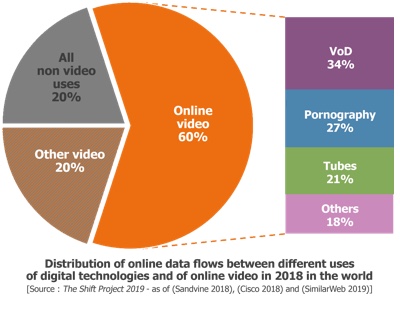 Transmitting and viewing online video accounts for a large portion for these emissions. The Shift Project also calculated that a quarter of the videos watched online are porn.
Transmitting and viewing online video accounts for a large portion for these emissions. The Shift Project also calculated that a quarter of the videos watched online are porn.
In 2019, the digital has consumed roughly 10% perhaps even more of world electricity. Some of that electricity relies on burning fossil fuels. These figures obviously vary depending on where in the world you are. Internet users in Europe or in the US will have a disproportionately large footprint.
And that’s just the energy, I’m not even talking about the material and geological dimensions of digital technology. Even a single email exchange requires smart devices but also heavy infrastructures made of undersea cables and data centres that involve massive extraction of minerals, appropriation of water, use of energy, toxic chemical processes and poor management of e-waste.
A few weeks ago, I curated a panel for the KIBLIX festival of art, science and technology in Maribor, Slovenia, that looked at how activists, thinkers, researchers and creative minds are trying to not only make us more aware of the problem but also to make technology more “frugal” or sustainable.
KIBLIX 2021 / The (Heavy) Carbon Footprint Of Our Virtual Life, with artist and researcher Joana Moll, journalist and writer Kris De Decker, artist and researcher Paul O’Neill
The panel guests were artist Joana Moll, journalist Kris de Decker and researcher Paul O’Neill. None of them can be summed up in one word because each of their practice also involves plenty of investigation, activism, creativity and knowledge-sharing.
Some of the questions raised during the panel included: What is the environmental cost of WFH (working from home)? Can digital technology ever be sustainable? Which strategies do artists use to make the carbon footprint of the virtual world visible? How can we, citizens and users of technology, use digital tools in a more “frugal” way?
And yes, I’ve painfully transcribed the conversation because I will always choose texts over videos and I thought that adding a few links here and there might be useful if ever anyone wants to investigate further. Let’s start with the first speaker in the panel:
Joana Moll is an artist and researcher. Her work investigates -among other issues- internet surveillance and social control, as well as the precarious balance between politics, economics, data, technology, humans and nature. She is co-founder of the research group Critical Interface Politics based at Hangar in Barcelona. She is a visiting lecturer at Potsdam University (DE), Escola Elisava which is Barcelona’s school of design and engineering and Escola Superior d’Art de Vic, an art academy in Barcelona.
Moll is one of the first artists who made the ecological impact of digital technology clear and easy to understand for all of us, with – for example- one artwork that visualises how much C02 is generated from searches on Google.com and later with a web page that visualises how many trees are necessary to offset one second of Google searches. Both works were developed at a time when, as she says, the equation wasn’t embedded in the social imagination.
Some of her most recent works intersect this concern for the environment with other pressing issues such as greenwashing, technosolutionism and how tech platforms exploit our free labour or track our behaviour online.
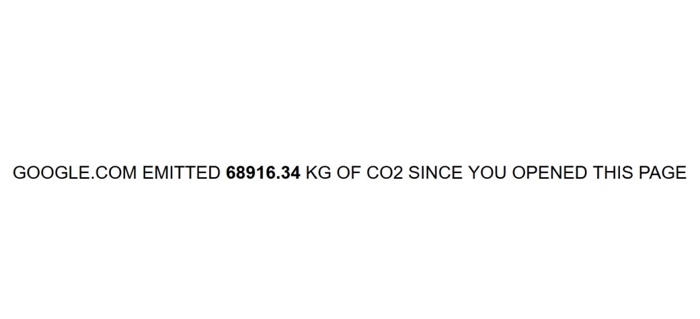
Joana Moll, CO2GLE, 2014
Launched in 2014, CO2GLE makes visible how energy-intensive internet is. The work started with a simple question “How can this data come “for free”?” Her research on the topic started in 2013 when almost no one was really looking into the problem. Google.com calculates the amount of emissions derived from the global visits to Google.com per second. It’s an estimation because quantifying the environmental footprint of our data is a challenging task: the whole system and its infrastructure are so massive, there are so many agents involved in the configuration and the operation of the internet that it is impossible to determine its emissions with precision. It’s the same with other industries: it’s impossible to trace the complete supply chain.
After this project, Moll felt that numbers tell a lot but they do not say a lot. What do these numbers represent for humans and for ecosystems? What is the physical cost of something as intangible as the internet?
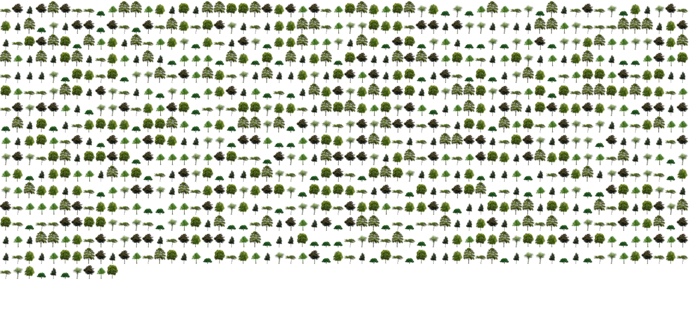
Joana Moll, DEFOOOOOOOOOOOOOOOOOOOOOREST (detail), 2016
DEFOOOOOOOOOOOOOOOOOOOOOREST visualises the average amount of trees that we would need every second in order to absorb the emissions derived from the global visits to google.com: an average of 23 trees per second. Again, it is an estimation but the point was not to be precise, it was to establish a visible connection between our online behaviours and the ecosystems they affect.
The artist has been researching the digital economy apparatus from different perspectives and one of her current research focus is the commercialisation of data ecosystems in terms of surveillance, online tracking, data gathering, etc.
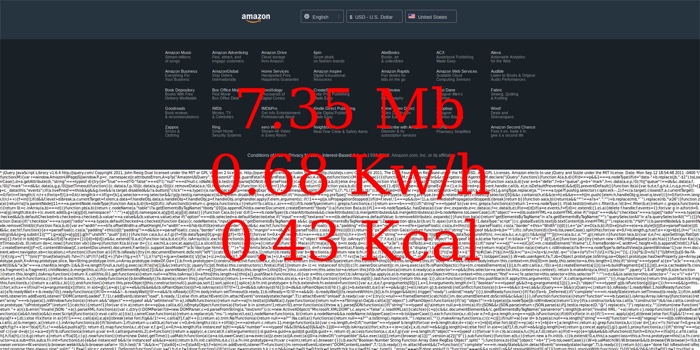
Joana Moll, The Hidden Life of an Amazon User
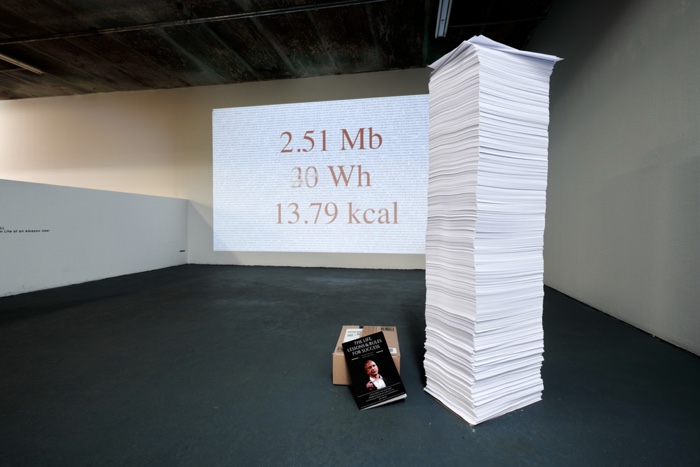
Joana Moll, The Hidden Life of an Amazon User. Installation view of the exhibition “BIG D@T@! BIG MON€Y!” (HALLE 14, Leipzig, Germany) / Photo: Walther LeKon
Her project The Hidden Life of an Amazon User stems from a concern about the heavy environmental footprint of the users’ data collected by tech companies. While purchasing a book by Jeff Bezos on Amazon, Moll first tracked every single interface that the platform made her go through in order to buy the book. Even though she did the minimum number of steps required, she still encountered a total of 12 interfaces. The second layer of that research consisted in intercepting all the codes that made the interactions with the website possible during the purchase. As Julian Oliver explained during a workshop, she attended many years ago, when you visit a website, it’s actually the page that visits you. All the code is downloaded onto your computer which means that part of the energy cost of operating a website falls onto the user. Around 10 000 pages of written code were then downloaded on her computer. She then printed out all the code that she had intercepted.
This project visualises the multiple strategies Amazon employs to exploit its users. The e-commerce giant makes money out of exploiting user data through the monitoring and analysis of every single activity we have on its website (which, by the way, is the main business model of the digital economy), it also delegates to the user a part of the environmental impact and energy cost of a business model that relies on the exploitation of the data of that same user.
There’s no negotiation whatsoever at any point in this process.
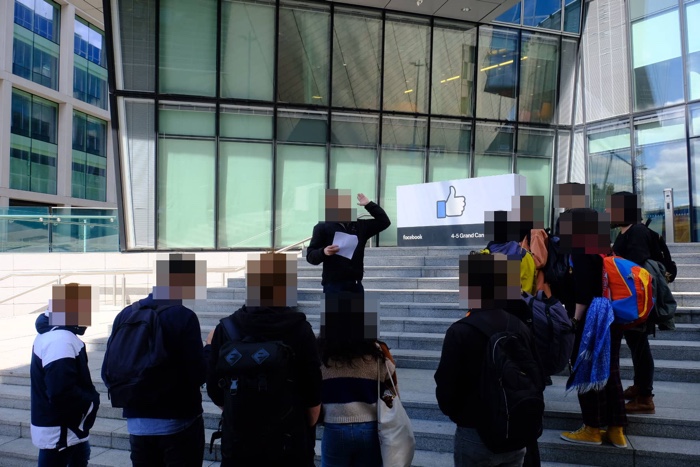
A tour of the Internet’s physical infrastructure in Dublin with Paul O’Neill. Photo credit: Harikrishnan Sasikumar
The next speaker was Paul O’Neill, a PhD researcher based in the School of Communications in Dublin City University. His practice and research are concerned with the implications of our collective dependency on networked technologies and infrastructures. His contribution attempted to Map Ireland’s Data Ecologies. The researcher and artist presented some of his work on Ireland’s relationship with the many tech companies that are based in the country. Not just focusing on the corporate aspect but also on the physical internet and the different ways that corporate and physical overlap with each other in Dublin, in Ireland and from there with the rest of Europe.
Google, LinkedIn, Twitter, Microsoft, Facebook… are all based in Dublin and more specifically in the part of the city called Grand Canal Dock and nicknamed Silicon Docks. Others call it the Google Ghetto.
Ireland’s relationship with tech companies has a long history: IBM set up an office here in 1956 and other tech and medical tech companies followed. Apple has been in Ireland for 40 years, Microsoft 35 and Intel and Dell for 30 years.
There are plenty of reasons why they chose Ireland: the geographical location, its membership of the EU, the English-speaking population, the presence of a skilled workforce and the Irish government’s attractive foreign direct investment policy. In 1999, Ireland reduced its corporate tax rate from 32% to 12.5%. The Apple tax case is often mentioned in this context because it shows how complex and interwoven the relationships between the Irish economy and these companies are.
What are the implications of having these companies in Ireland in relation to data?
Facebook has been in Ireland since 2008. The address of the building is 44 Grand Canal Square but the name of the street is actually Misery Hill. And Facebook has indeed generated a lot of misery related to the Cambridge Analytica scandal, hate speech, data collection, the predicament of moderators, etc. Ireland is Facebook’s European, Middle Eastern and African headquarter. It means that due to the EU’s GDPR, any issue related to data in relation to Facebook have to be solved within the country where they are registered. Which in this case is Ireland. This means that the Irish data protection commission has become the de facto pan-EU regulator for Facebook and many of the other tech companies based in Dublin. In 2007, privacy advocate Max Schrems initiated a series of legal challenges against Facebook through the Irish data protection commissioner about the transfer of his data as an EU citizen to the United States. The action resulted in the Safe Harbour agreement, a set of privacy principles developed to protect the data of EU citizens from being transferred to the US by American companies. He was successful in this case. He’s recently been challenging Whatsapp and Instagram (part of Zuckerberg’s empire) which, again, are regulated by the Irish data protection commissioner.
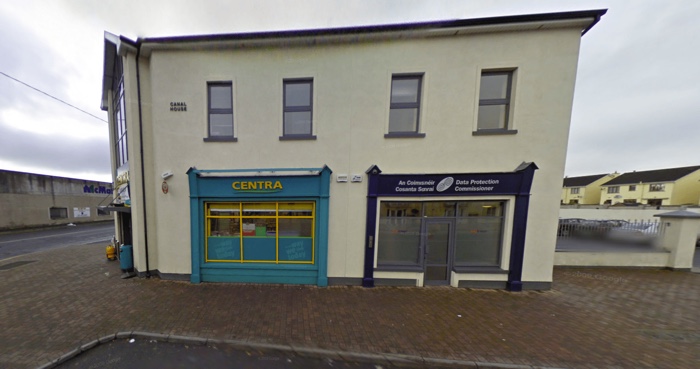
Office of the Irish data protection commissioner in Portarlington, Ireland. Photo via Quartz
On the left side of the image above is a convenience store. On the right, is the Office of the Irish data protection commissioner in a small rural town 70 km outside of Dublin city. To be fair, they have since opened a secondary office in Dublin. This image tells us a couple of things. First of all, the attitude of the Irish government in relation to data protection issues is an “out of sight, out of mind” mentality. It also gives a sense of scale in relation to regulating these companies. This scale is also apparent financially. The budget for the IDPC this year is about 20 million euros, a pitiful budget in comparison to the ones of the tech companies.
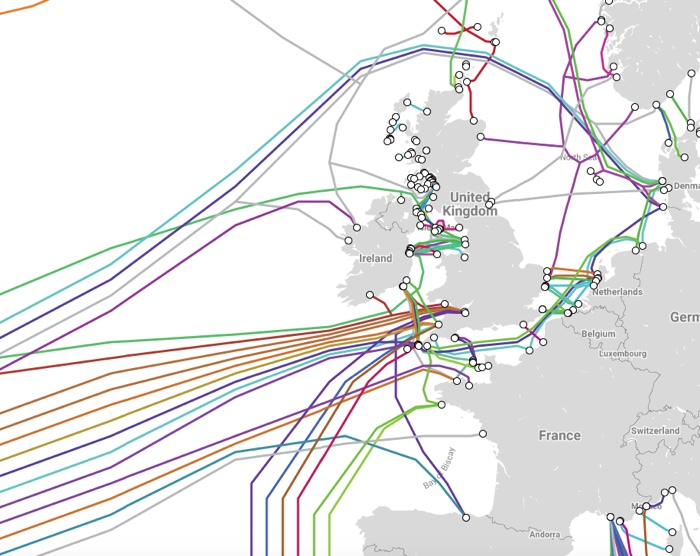
A closeup of the cables which land on Irish shores (credit: TeleGeography)
But what about the more physical aspects of the internet?
Let’s consider how Ireland connects with the rest of the world.
There are 16 undersea cables land in the Republic of Ireland. They vary in length, the shorter one being 120 km, it goes to Wales. The longest is about 12 000 km and it connects the US to the UK. All of these cables connect Ireland to the US or the UK which is interesting if you think about Ireland’s historical relationship with these countries in terms of trade and emigration. This relationship is now increasingly centred on data.
The T50 fibre optic cable stretches around the city of Dublin. It follows the tracing of the motorway and was originally installed in 2001 to offer connectivity for many of the business parks located in the proximity of the motorway. These business parks would have hosted many of the tech industries already mentioned. As a consequence of this, another business has emerged in these business parks: the data centre industry.
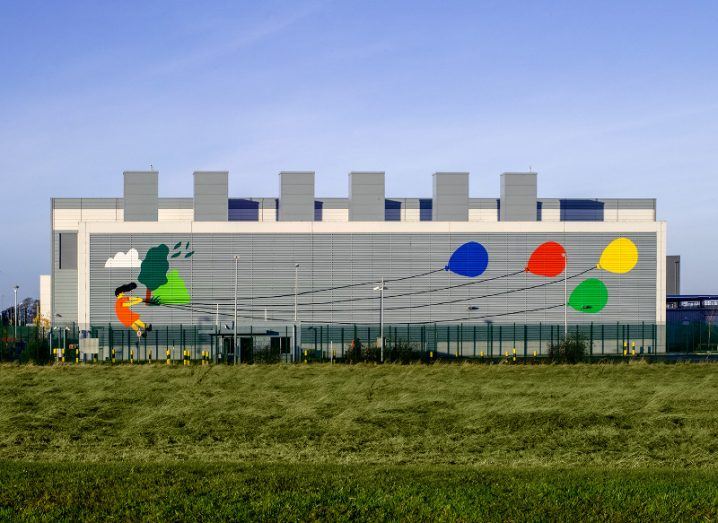
Google data centre in Dublin. Image: Noah Kalina
At the moment, there are about 60 operational data centres in Ireland, most are based in the suburbs of Dublin. The data centre industry is projected to contribute about 13 billion euros to the Irish economy by 2025. 77% of these data centres are hyper scale, they are owned and operated by the companies whose data they hold. In this case: Amazon, Microsoft, Amazon, Facebook, etc. In relationship to techno-politics, plenty of issues regarding these companies should worry us. One of them is the environmental consequences of these operations. It has been estimated that by 2028, they will consume about 29% of Ireland’s electricity. In contrast to worldwide consumption of energy by data centre which is around 1 to 2% but is set to reach 8% by 2030.
The companies claim that they are doing their best and switching to renewable energy. They claim that their Irish data centres are energy-efficient and that they are entirely supplied (or will soon be) by renewable energy. Over the last year or two, Amazon Web Services have announced that they are investing in wind farms on the West coast of Ireland.
Academics Patrick Bresnihan and Patrick Brodie questioned Amazon’s involvement in these clean energy projects. They suggest that tech companies might just be piggybacking on national efforts to decarbonise. The wind farms power new data centres, they are not used to reduce existing emissions.
“AWS in 2019 signed two contracts with wind farms in Ireland… these are not Amazon-owned wind farms, not is it even clear if Amazon is directly investing in the wind farm developments.”
We need to be wary of these sustainable commitments of big tech in relation to data and data centres.
Data Futures
In Ireland, these data centres are “critical infrastructure” which means that their planning permission is fast-tracked by authorities. At the moment, 26 data centres are awaiting planning approval. 12 are currently under construction. Amazon will build another huge data hub costing 1 billion euros. TikTok has also announced that they will have their first European data centre in Dublin.
The ability to communicate with each other online is built upon an infrastructure of planetary scale. A large part of that infrastructure is based in Ireland, a small and peripheral country. A combination of location, transnational agreements and alliances as well as economic opportunism allowed the country to become a key node of the internet infrastructure. This comes with enormous responsibility. There is a need for more regulation of those companies alongside transparency in relation to their financial practices, data responsibility and climate commitments. It’s not clear whether Ireland or any other country is able to regulate these companies but that should not diminish the need for us to do so.
A massive part of Amazon AWS is based in Dublin. If you look at what AWS are doing elsewhere (for example their ties with the US military and other organisations), you realise how problematic this situation is. The Snowden scandals revealed that many undersea cables have been tapped by British intelligence. More recently, there’s been reports (albeit unconfirmed) in Irish media that Russian operators are now targeting Irish cables, raising concerns that they might be able to destroy them.
This shows how big players on the international scene might be using the key role that a small country like Ireland plays when it comes to internet infrastructures.
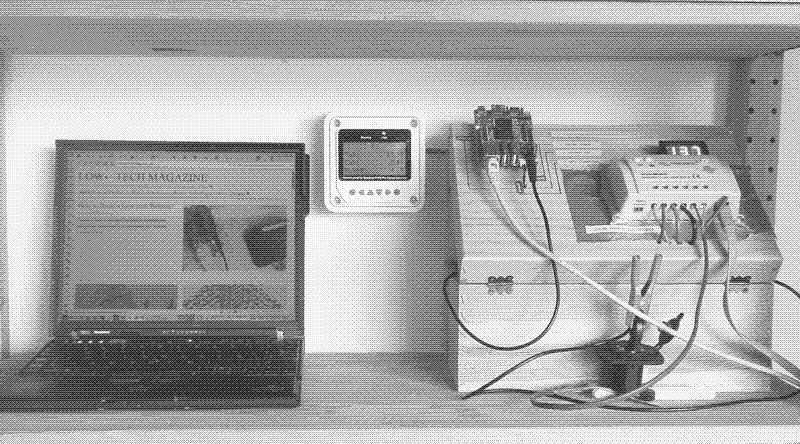
The second prototype of the solar-powered server that runs Low-tech Magazine
The final speaker was Kris De Decker, the creator and author of Low-tech Magazine, of No Tech Magazine and the co-creator of the Solar Powered Website.
For a long time, we have been told that the internet is a sustainable alternative to a lot of physical activities. We do not need to drive cars to go to the bank anymore. We don’t need to buy CDs either. This translates into the way we picture the internet: it’s a cloud, it’s immaterial and floating around. The reality is that behind the internet, there is a massive physical infrastructure and escalating consumption of resources and energy.
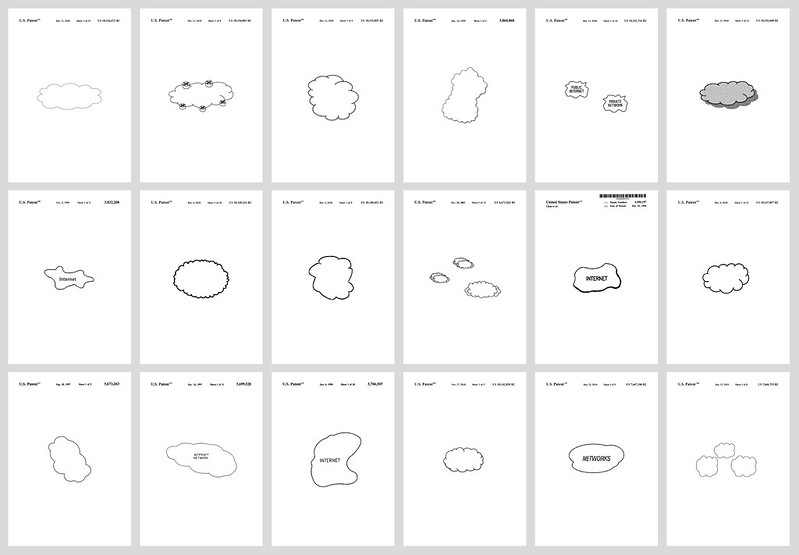
Mario Santamaria, Cloudplexity, 2019
3 reasons why internet use keeps on increasing:
1. the content on the internet is getting heavier and heavier. Between 2010 and 2020, the average web page has increased threefold. We use more images and more videos. And these have increasingly higher resolutions. This means that more energy is required to visualise and navigate these pages. We also need increasingly powerful computers to access these contents.
2. We are always online. Often using more than one connected device at the same time.
3. All the data traffic which has nothing to do with content and is hiding behind the scene: advertising, tracking services, software upgrades, etc. Just the software upgrades already equal in data traffic the entire internet data traffic from 2007.
Awareness of the problem is growing.
The solution proposed is to throw more renewable energy at the problem. Just like we think that the solution to the car problem is to make them electric.
Greenpeace’s Clicking Clean report rates big companies in terms of renewable energy uses. In the Netherlands, a country with one of the highest concentrations of data centres in continental Europe, people started protesting when they figured out that the companies building data centres are in fact using up all the renewable energy provided in these provinces. Google, Microsoft, Facebook and others claim that they are powered by 100% renewable energy but that is often at the expense of the households and the businesses that live in the area and have to use fossil fuels again. The Dutch case shows that it is not that easy to switch from fossil fuels to renewable energy. And that we also need to address the continuous increase in data traffic.
De Decker is also aware of the irony of using the internet to denounce the ecological cost of the internet. In 2017, he got an offer from Lauren Traugot-Campbell and Marie Otsuka to redesign the website. That was an opportunity to finally build a low-tech website. Network artist Roel Roscam Abbing, who builds his own servers, joined the team.
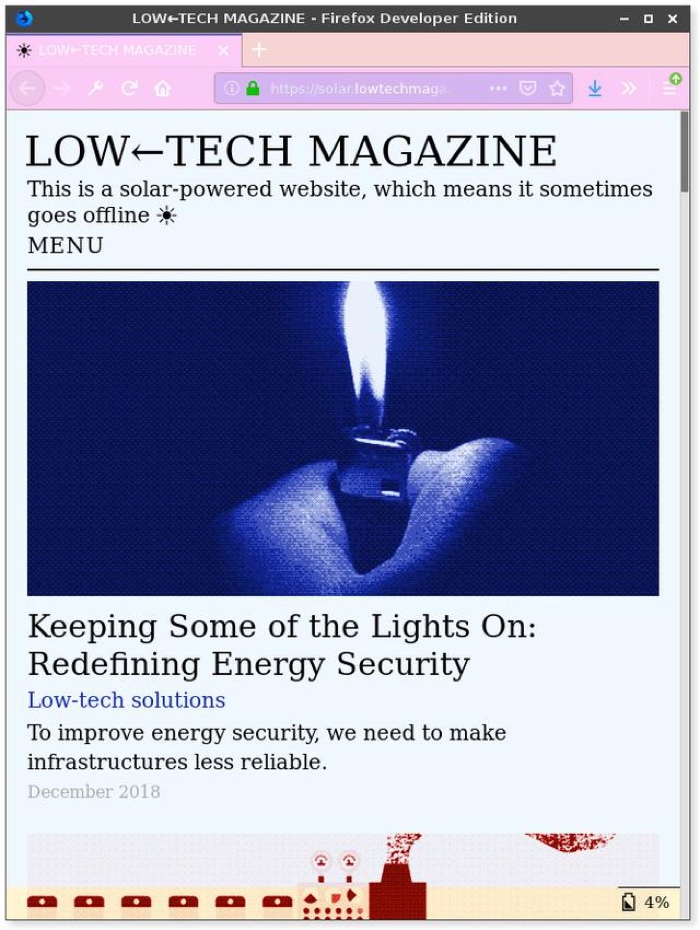
Redesign of Low-Tech Magazine
Here is the result:
– the design of the website is at least 10 times lighter than the old website,
– there’s no advertisement, no cookies, etc. Nothing but the content. You surf it anonymously.
– it is solar-powered and because it is dependent on the sun shining, it is not always online.
Kris and the designers also wanted to reveal the infrastructure behind the website because usually it is hidden by design which makes that people are not aware that the internet is a problem. Being located near Barcelona, Kris went for solar energy but was limited by the size of his balcony. Since he couldn’t run a typical server with such a small solar panel, he used a smaller machine that is consuming between 1 and 2.5 watts of power.
The typical web designers do not design within energy limits. No one ever tells them to design a website so that can run on a 50 watts solar panel. Using a solar panel is not the most important element (what is more important is that the website is light) but it makes it clear that we have a limited supply of energy.
The motto of Low-Tech magazine has always been that if you have a problem, look at it through a historical lens, look to the past for inspiration. And that applies also to the internet! Our website is inspired by the first website ever built in the late 80s, early 90s.
The differences with today’s websites is that:
– the website is static. You basically open a document on their server, just like you would open a document on your laptop. Low-Tech Magazine re-generates the website every 24 hours. Whereas most pages today are dynamic which means that they are generated every time someone wants to visit them.
– early internet websites used to feature only text. There were no images, let alone videos. LTM didn’t want to get rid of the images so they compressed them with dithering, a technique that was common in the early days of video games when video cards didn’t have many colours. LTM shows that compression, as a part of their desire to reveal the process. But you could use the same technique of compression and the images would still look very similar to the original ones.
– another difference is that in the old websites, “the browser is the web designer.” Today, web design is constantly overriding the browser capacity to design a website. The way the LTM website looks depends on each visitor. It depends on the browser they use and the font they have selected as their browser font. That saves a lot of requests to the server. You don’t need to load custom fonts. LTM did something similar with the logo.
A static website has some drawbacks, of course. For example, the comments only get updated every 24 hours. There is no comment form, LTM readers have to send a message to the editor and they actually do it.
All the design decisions pay off.

Redesign of Low-Tech Magazine (comparison with the previous one)
Compared to the old website, there is a difference in page size by a factor of 20.
The requests to the server are also very much diminished and it is faster. If you want to make cars more sustainable, they are probably not going to get faster. That’s not the case for websites: a website that’s sustainable uses less energy and is faster. A very light website design is accessible to people with slow internet and old computers.
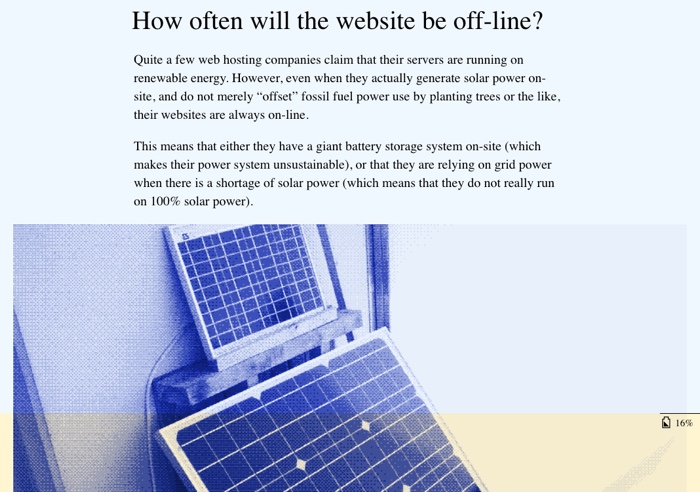
Screenshot of Low-Tech Magazine website, via trendhunter
It’s not just the solar panel that imposes limits, it’s also the batteries necessary for energy storage. Batteries are very energy-intensive to produce, they are expensive and they have a very short lifespan. They are the most unsustainable component in any off-the-grid system. Kris and the designers chose a fairly small battery. It keeps the site online through the night. It can stand one or maybe two days of bad weather but after that, it goes down. Every off-the-grid system is a compromise between unreliability and unsustainability. The system has been running for 2 years: the uptime has been 95% so far which means that the website is offline 20 days per year, with no interruption at all between May and November. To get 100% reliability, the system would need 7 times more batteries (at a far greater environmental cost in terms of extraction of raw materials and of production). In a way, the system is going back to a time when renewable energy was everywhere: windmills, sailing boats, etc. In the same tradition, the designers and Kris decided that the website wouldn’t always be accessible. People have proposed solutions to this intermittent availability but since being always online is part of the problem, Kris believes that the website should remain as it is.

The printed version of Low-tech Magazine . Image: Jordi Parra
Clues inform the readers about the functioning of the website: there’s a battery meter, a weather forecast for non-Barcelona residing visitors, etc. The team also made a printed version of the website because, in the end, it’s the content that matters.
Previously: KIBLIX 2021: Can technology bring back long-lost nature?; A guided tour of Dublin’s physical Internet infrastructure; Taking data packets for a ride. An interview with Mario Santamaria; Critical investigation into the politics of the interface. An interview with Joana Moll; Can you design a website on a (very) limited energy budget? An interview with Gauthier Roussilhe.
